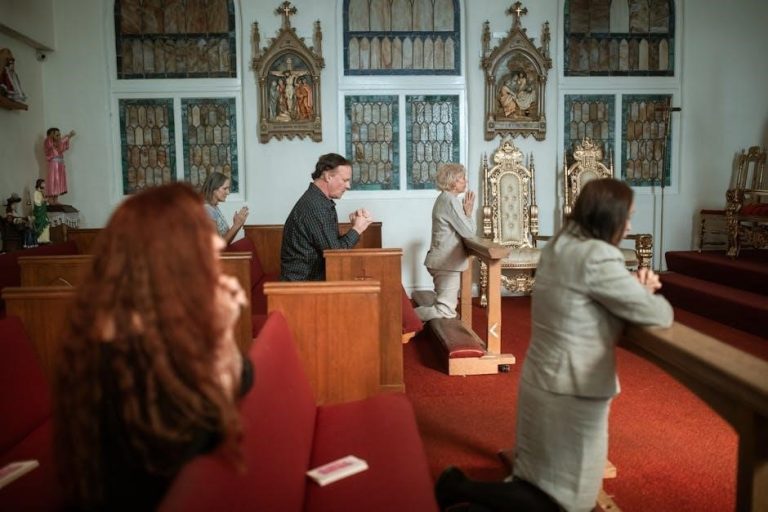The Catholic Tenebrae Service, derived from the Latin word for darkness, is a solemn Holy Week observance. It features the gradual extinguishing of candles, symbolizing the diminishing light of Christ’s earthly presence. This service, often held on Wednesday, Thursday, or Friday of Holy Week, combines readings, chants, and prayer to reflect on Christ’s Passion and death. The Tenebrae Service PDF provides a structured guide for participants, ensuring a meaningful and contemplative experience during this sacred period.
What is the Tenebrae Service?
The Tenebrae Service is a solemn Catholic liturgical observance during Holy Week, symbolizing the darkness and shadows of Christ’s Passion. Derived from the Latin word for “darkness,” it involves the gradual extinguishing of candles, representing the fading light of Christ’s earthly presence. The service combines readings, chants, and prayers, creating a reflective atmosphere for meditation on Christ’s suffering and death. A Tenebrae Service PDF often serves as a guide, outlining the structure, including the Office of Readings and Morning Prayer, to help participants engage deeply with the spiritual significance of the occasion.
Significance of Tenebrae in Holy Week
The Tenebrae Service holds profound significance in Holy Week as it symbolizes the darkness and shadows surrounding Christ’s Passion. Through the gradual extinguishing of candles, it vividly represents the diminishing light of Christ’s earthly presence and the spiritual darkness before His resurrection. The service fosters deep reflection on His suffering and death, preparing believers for the Easter Triduum. The Tenebrae Service PDF serves as a vital resource, guiding participants through prayers, readings, and chants, enhancing their spiritual preparation and connection to the sacred events of Holy Week.
Overview of the Tenebrae Service PDF
The Tenebrae Service PDF is a comprehensive guide for participants, outlining the structure and content of the solemn Holy Week observance. It includes the Office of Readings (Matins) and Morning Prayer (Lauds), featuring sacred chants like the Lamentations of Jeremiah. The booklet details the gradual extinguishing of candles, symbolizing the diminishing light of Christ’s presence. Designed for use during services held on Wednesday, Thursday, or Friday of Holy Week, the PDF provides prayers, readings, and instructions, ensuring a meaningful and structured participation in this profound liturgical tradition.

Historical Background of Tenebrae
Tenebrae, rooted in ancient monastic traditions, dates back to the 4th century. Initially part of night and early morning services, it evolved into evening observances during Holy Week.
Origins of the Tenebrae Service
The Tenebrae Service, meaning “darkness” in Latin, traces its origins to ancient monastic practices during Holy Week. Initially observed as night and early morning services, it later transitioned to evening observances. The service reflects the diminishing light of Christ’s earthly presence through the extinguishing of candles, symbolizing His Passion. Rooted in medieval liturgy, Tenebrae incorporates readings, chants, and silent reflection, drawing from the Lamentations of Jeremiah. This solemn tradition invites participants to meditate on Christ’s suffering and death, preparing spiritually for Easter.
Evolution of the Service Through the Centuries
The Tenebrae Service has evolved from ancient monastic practices, initially observed as night and early morning vigils. Over time, it transitioned to evening services, incorporating elements like the Lamentations of Jeremiah. The use of candles, gradually extinguished to symbolize Christ’s diminishing light, became central. Formalized by the Catholic Church, Tenebrae retained its core elements while adapting to liturgical reforms. Today, the service remains a powerful reflection on Christ’s Passion, with modern resources like the Tenebrae Service PDF booklet aiding participation and maintaining its timeless spiritual significance.
Role of Tenebrae in the Catholic Liturgical Calendar
Tenebrae holds a profound place in the Catholic liturgical calendar, particularly during Holy Week. It serves as a poignant reflection on Christ’s Passion, bridging the gap between Lent and Easter; Observed on Wednesday, Thursday, and Friday of Holy Week, the service symbolizes the darkness that fell during Christ’s crucifixion. The gradual extinguishing of candles represents the diminishing light of Christ’s earthly presence, while the readings and chants deepen the congregation’s meditation on His sacrifice. The Tenebrae Service PDF booklet is an essential resource, guiding participants through this sacred and contemplative tradition, enriching their spiritual preparation for Easter.
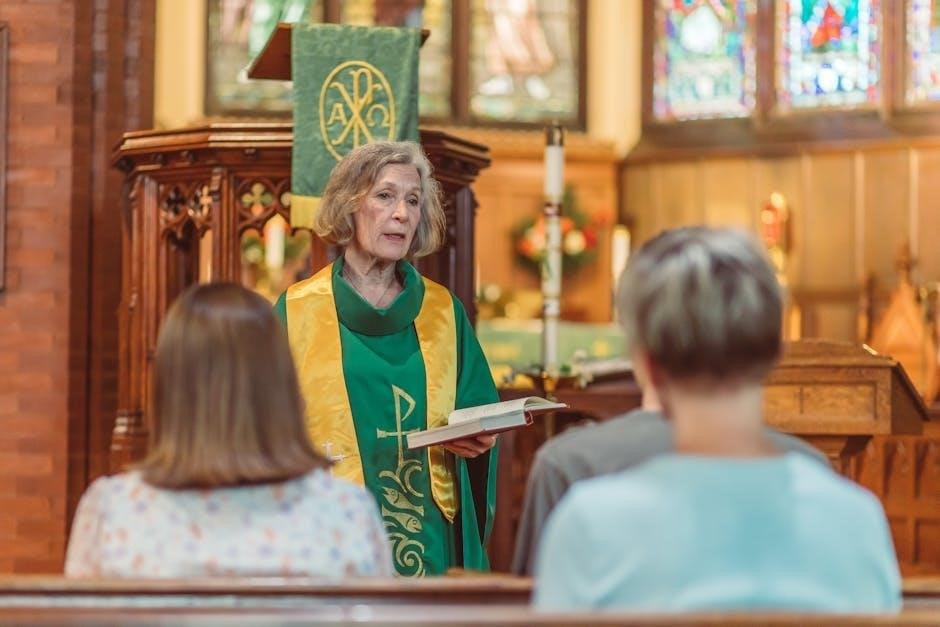
Structure of the Tenebrae Service
The Tenebrae Service is structured around the Office of Readings (Matins) and Morning Prayer (Lauds), featuring readings, chants, and the symbolic extinguishing of candles, deepening the meditation on Christ’s Passion.
Office of Readings (Matins)
The Office of Readings, or Matins, is a pivotal part of the Tenebrae Service, typically conducted early in the morning. It involves the recitation of psalms and scriptural readings, focusing on the Passion of Christ. The service often includes the chanting of the Lamentations of Jeremiah, which poignantly reflect on the suffering and death of Jesus. This segment encourages deep reflection and prayer, setting a contemplative tone for the rest of the Tenebrae Service.
Morning Prayer (Lauds)
Morning Prayer, or Lauds, is a sacred segment of the Tenebrae Service, traditionally held at dawn. This part of the service is characterized by the chanting of psalms and canticles, such as the Benedictus and the Te Deum. The prayers and hymns focus on themes of praise, thanksgiving, and the resurrection, offering a contrast to the somber reflections of the Passion. Lauds serves as a powerful reminder of the hope and redemption that Easter brings, even amidst the darkness of Christ’s suffering.
Key Components: Readings, Chants, and Candles
The Tenebrae Service is defined by three central elements: sacred readings, haunting chants, and the symbolic use of candles. The readings, often from the Lamentations of Jeremiah, recount Christ’s Passion, while traditional chants like the Benedictus and psalms deepen the contemplative atmosphere. Candles, representing Christ and the Apostles, are gradually extinguished, mirroring the darkness that fell during Christ’s crucifixion. These components weave together to create a powerful, meditative experience, drawing participants into the mystery of Christ’s suffering and death.

Symbolism in the Tenebrae Service
The Tenebrae Service is rich in symbolism, with darkness representing sin and Christ’s absence. The gradual extinguishing of candles mirrors the Apostles’ desertion and Christ’s ultimate death, while shadows evoke the Passion’s mystery.
The Meaning of Darkness and Light
In the Catholic Tenebrae Service, darkness symbolizes sin, separation, and Christ’s absence, while light represents divine presence and redemption. The gradual extinguishing of candles mirrors the diminishing light of Christ’s earthly presence, evoking a sense of loss and contemplation. This interplay of shadows and light invites reflection on the spiritual journey from sin to redemption. The darkness ultimately gives way to the promise of resurrection, as the Paschal candle’s return signifies Christ’s triumph over death, connecting the service to the Easter Triduum and the renewal of faith.
Significance of the Extinguished Candles
The extinguished candles in the Tenebrae service symbolize the gradual withdrawal of Christ’s disciples and the fading light of His earthly presence. Each candle represents one of the fifteen Psalms of ascent, with the final candle, often representing Christ, being removed entirely, signifying His death and burial. This dramatic display underscores the isolation and darkness of His Passion, inviting participants to reflect on the gravity of sin and the triumph of redemption through His resurrection, culminating in the return of light at Easter.
Use of Shadows to Represent Christ’s Passion
The Tenebrae service employs shadows to vividly depict the darkness surrounding Christ’s Passion. As candles are extinguished, the increasing shadows symbolize the spiritual darkness that enveloped the world during His crucifixion. This dramatic visual representation heightens the emotional and theological impact of the service, inviting participants to contemplate the depth of Christ’s suffering and the temporary triumph of evil. The shadows serve as a poignant reminder of the separation from God’s light, ultimately preparing the faithful for the joyful resurrection at Easter.

The Tenebrae Service PDF Booklet
The Tenebrae Service PDF booklet is a printable guide for Holy Thursday, offering structured readings, chants, and prayers. It aids participants in following the solemn liturgy, enhancing their spiritual experience.
Contents of the Tenebrae Booklet
The Tenebrae booklet includes the Office of Readings (Matins) and Morning Prayer (Lauds) for Holy Week, featuring psalms, scriptural readings, and traditional chants like the Lamentations of Jeremiah. It provides a structured guide for the service, outlining the gradual extinguishing of candles and the prayers associated with each step. The booklet also contains reflections on Christ’s Passion and death, offering a spiritual framework for participants to deepen their contemplation; Designed for use on Holy Thursday, it is available as a downloadable PDF, ensuring accessibility for modern worshippers.
Prayers and Readings Included in the PDF
The Tenebrae PDF includes prayers and readings from the Office of Readings and Morning Prayer, such as psalms, scriptural passages, and the Lamentations of Jeremiah. These readings reflect on Christ’s Passion and death, while prayers like the Canticle of Zechariah and the Benedictus are integral to the service. The booklet also features collects and antiphons, guiding participants through moments of reflection and meditation. These elements create a somber and contemplative atmosphere, helping worshippers connect with the spiritual significance of Holy Week.
Importance of the Booklet for Participants
The Tenebrae booklet is essential for guiding participants through the service, ensuring a unified and meaningful experience. It provides clear instructions, readings, and prayers, helping individuals follow the liturgy seamlessly. For those unfamiliar with the service, the booklet serves as a valuable resource, offering context and enhancing understanding. It also fosters active participation, allowing worshippers to engage deeply with the spiritual themes of Holy Week. The booklet’s structured format ensures that the solemnity and contemplative nature of Tenebrae are preserved, making it a vital tool for spiritual reflection and connection with Christ’s Passion.
Prayers and Reflections in Tenebrae
The Tenebrae Service includes specific prayers and reflections that focus on Christ’s suffering and death. These elements, found in the Tenebrae PDF booklet, guide participants in meditative devotion.
Specific Prayers Used in the Service
The Catholic Tenebrae Service incorporates specific prayers, including psalms, readings, and the Lamentations of Jeremiah. These prayers, outlined in the Tenebrae PDF booklet, are central to the service. They guide participants through meditative reflection on Christ’s Passion, emphasizing His suffering and sacrifice. The prayers are drawn from the Office of Readings and Morning Prayer, traditionally part of the Liturgy of the Hours. This structured approach ensures a deeply contemplative experience, fostering spiritual connection and devotion during Holy Week.
Reflections on Christ’s Suffering and Death
The Tenebrae Service invites profound reflection on Christ’s suffering and death through its symbolic use of darkness and light. The gradual extinguishing of candles represents the spiritual darkness that fell during Christ’s crucifixion. Participants are guided to contemplate the depth of His sacrifice, as readings and chants from the Tenebrae PDF booklet recount the Passion narrative. This solemn observance fosters a deep emotional and spiritual connection, encouraging believers to meditate on the redemptive power of Christ’s death and its transformative impact on humanity, while anticipating the hope of Easter Sunday.
Guided Meditation During the Service
The Tenebrae Service incorporates guided meditation, encouraging participants to reflect deeply on Christ’s journey to Calvary. As candles are extinguished one by one, the increasing darkness symbolizes the spiritual shadows surrounding His Passion. The service includes moments of silence and specific prayers from the Tenebrae PDF, inviting believers to contemplate the weight of sin and the triumph of God’s love. Through this meditative experience, individuals are drawn into the story of redemption, fostering a profound connection to the sacrifice and resurrection of Christ, and preparing hearts for the Easter celebration.
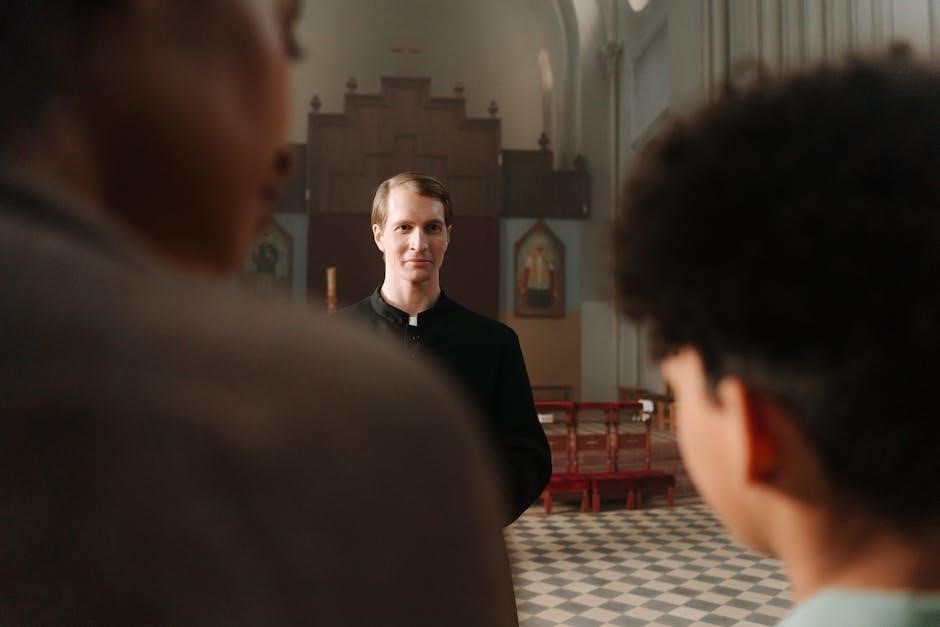
Music in the Tenebrae Service
Traditional chants and hymns are central to the Tenebrae Service, creating a somber atmosphere. The Lamentations of Jeremiah are chanted, enhancing the reflective mood.
Traditional Chants and Hymns
Traditional chants and hymns are integral to the Tenebrae Service, creating a somber and reflective atmosphere. The Lamentations of Jeremiah are chanted, their haunting melodies evoking the sorrow of Christ’s Passion. These ancient chants, often in Latin, are sung a cappella, emphasizing the solemnity of the occasion. The hymns, such as the Miserere and Alleluia, are deeply rooted in Catholic tradition, their lyrics and melodies inspiring meditation on Christ’s suffering and death. This musical tradition underscores the spiritual gravity of Holy Week, fostering a profound connection to the liturgical experience.
Role of the Lamentations of Jeremiah
The Lamentations of Jeremiah hold a central role in the Tenebrae Service, traditionally chanted during the Office of Readings. These prophetic texts, often sung in Latin, express deep sorrow and repentance, reflecting on the fall of Jerusalem and foreshadowing Christ’s Passion. Each verse is accompanied by a gradual dimming of light, symbolizing the spiritual darkness before Christ’s resurrection. This ancient tradition enriches the liturgical experience, inviting participants to meditate on the gravity of sin and the redemption achieved through Christ’s suffering.
Modern Musical Adaptations
Modern adaptations of the Tenebrae Service often blend traditional chants with contemporary musical expressions, enhancing the emotional depth of the liturgy. While Gregorian chant remains central, many communities incorporate polyphonic arrangements or instrumental accompaniment to enrich the experience. Some services feature choral ensembles or soloists performing modern compositions that reflect the somber yet hopeful tone of the Tenebrae. These adaptations ensure the service remains accessible while preserving its spiritual essence, offering a fresh yet reverent approach to the ancient tradition.
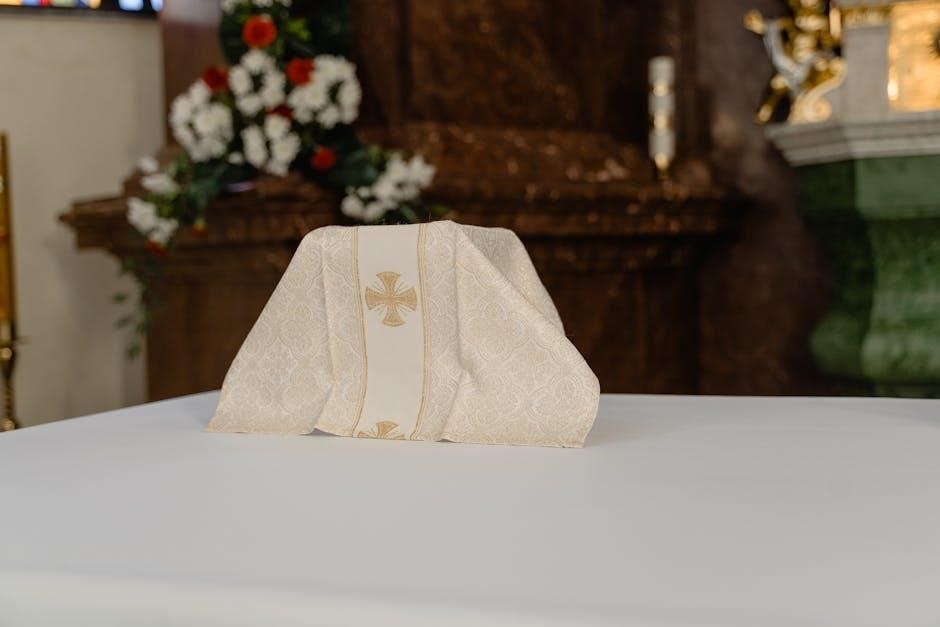
Theological Significance of Tenebrae
The Tenebrae Service profoundly reflects Christ’s Passion, symbolizing the darkness before resurrection. It deepens devotion to Easter’s promise, preparing hearts for spiritual renewal through somber reflection and prayer.
Representation of Christ’s Passion
The Tenebrae Service vividly represents Christ’s Passion through symbolic darkness and the gradual extinguishing of candles. This somber ritual mirrors the diminishing light of Christ’s earthly presence, reflecting His journey to Golgotha. The service’s structure, including readings and chants, recounts the events leading to His crucifixion, inviting participants to meditate on the depth of His suffering. The darkness symbolizes the spiritual shadows that shrouded the world during His death, while the eventual absence of light underscores the gravity of His sacrifice. This powerful imagery deepens devotion and prepares hearts for Easter’s renewal.
Connection to the Easter Triduum
The Tenebrae Service serves as a profound spiritual bridge to the Easter Triduum, the three-day celebration of Christ’s Passion, death, and resurrection. Observed on the evenings of Holy Wednesday, Thursday, and Friday, Tenebrae deepens the faithful’s reflection on the events leading to Easter. The gradual extinguishing of candles mirrors the darkness of Christ’s death, while the final, unlit candle symbolizes His burial. This somber yet hopeful ritual prepares hearts for the Easter Vigil, where light and life triumph over darkness, marking the resurrection of Christ and the fulfillment of salvation.
Spiritual Preparation for Easter
The Tenebrae Service plays a crucial role in spiritual preparation for Easter by fostering a deep reflection on Christ’s Passion and death. Through its somber rituals, including the extinguishing of candles and solemn chants, the service invites believers to confront the darkness of sin and death. This introspective experience cultivates a profound appreciation for the resurrection’s triumph, renewing faith and hope. By immersing participants in the mystery of Christ’s sacrifice, Tenebrae becomes a powerful catalyst for spiritual renewal, preparing hearts to embrace the joy and light of Easter Sunday.

Cultural Variations in Tenebrae Services
Tenebrae services vary across cultures, blending regional traditions with universal elements like candle extinguishing. Local customs enrich the liturgy, reflecting diverse expressions of faith and devotion worldwide.
Regional Traditions and Practices
Regional traditions enrich the Tenebrae service, reflecting local cultural influences. In some areas, traditional hymns and instruments are incorporated, while others emphasize specific chants or candle arrangements. For example, Latin American communities may blend indigenous music with traditional chants, creating a unique spiritual atmosphere. European churches often maintain ancient rituals, such as processions or specific litanies. These regional practices highlight the universal themes of Tenebrae while offering distinct expressions of faith, making each service a blend of global unity and local identity.
Local Customs and Deviations
Local customs often add unique dimensions to the Tenebrae service, reflecting parish traditions. Some communities incorporate additional prayers or chants, while others include reenactments of Christ’s Passion. Certain churches may use traditional instruments or distinctive candle arrangements, such as placing candles in a specific pattern or using blessed beeswax. These deviations enrich the service, offering a personal touch while maintaining the core liturgical structure. Such local practices foster a deeper connection to the faith community, blending universal themes with cultural expression.
Universal Elements Across All Services
Despite regional variations, universal elements unite Tenebrae services worldwide. The central use of candles, progressively extinguished, symbolizes the diminishing light before Christ’s resurrection. Traditional prayers, such as the Lamentations of Jeremiah, are consistently featured, alongside readings from the Passion narratives. These elements create a shared experience, connecting believers across cultures. The service’s structure, rooted in the Office of Readings and Morning Prayer, ensures a common liturgical framework. These universal components foster unity, emphasizing the sacred and solemn nature of the Tenebrae observance in the Catholic tradition.
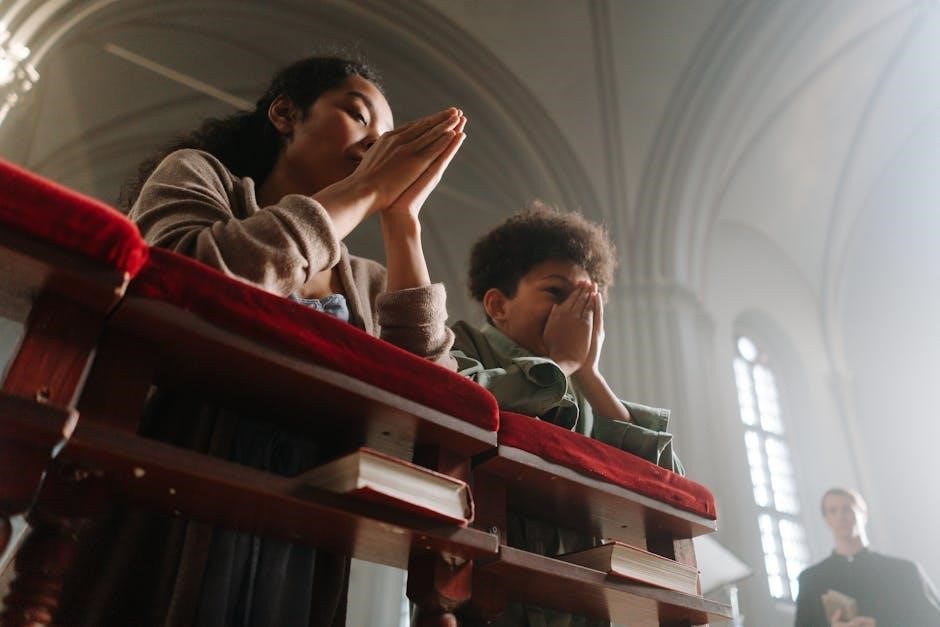
Attending a Tenebrae Service
Attending a Tenebrae service involves entering a darkened sanctuary illuminated by candles, gradually extinguished to symbolize Christ’s journey to death. Participants engage in prayers, chants, and reflection, creating a profound, meditative atmosphere.
Preparing for the Service
To prepare for the Tenebrae service, participants should familiarize themselves with the structure and significance of the observance. Reviewing the Tenebrae Service PDF booklet beforehand helps understand the readings, chants, and order of the service. Spiritual preparation involves reflecting on Christ’s Passion and death, fostering a mindset of solemnity and contemplation. Arriving early to the service allows time to settle in silence, ready to engage fully in the liturgical experience. Dressing modestly and being prepared for moments of silence and prayer enhances the participatory nature of the service.
Etiquette and Participation Guidelines
Participating in the Tenebrae service requires reverence and respect for its solemn nature. Arrive early to settle in before the service begins and refrain from loud conversations. Dress modestly to reflect the sacredness of the occasion. Follow the Tenebrae Service PDF booklet to engage with readings, chants, and prayers. Maintain silence during moments of reflection and candle extinguishing. Avoid distractions like cell phones and focus on the liturgical elements. Participate respectfully in communal prayers and chants, and observe the tradition of ending the service in silence, allowing the experience to linger in contemplation.
What to Expect During the Service
The Tenebrae service begins with a dimly lit sanctuary, where candles and minimal light set a somber tone. The liturgy includes the Office of Readings and Morning Prayer, featuring prophetic and Gospel readings. Chants, such as the Lamentations of Jeremiah, accompany the gradual extinguishing of candles, symbolizing the darkness before Christ’s resurrection. The service progresses in silence and reflection, culminating in a moment of complete darkness, followed by the departure of the congregation in contemplative silence, mirroring the disciples’ abandonment of Christ.

Modern Adaptations of Tenebrae
Modern adaptations of Tenebrae include online services, contemporary interpretations, and innovative uses of technology to enhance the traditional experience while preserving its spiritual essence and historical significance.
Online Tenebrae Services
Online Tenebrae services have become a modern way to experience this sacred tradition, offering accessibility to those unable to attend in person. Many churches stream the service on their websites or social media platforms, allowing global participation. These virtual services often include downloadable PDF booklets, such as the Catholic Tenebrae Service PDF, to guide followers through the prayers, readings, and chants. This innovation ensures the continuity of the Tenebrae tradition, blending ancient rituals with contemporary technology to reach a wider audience while maintaining its profound spiritual significance.
Contemporary Interpretations
Contemporary interpretations of the Tenebrae service blend traditional elements with modern creativity, ensuring its relevance for today’s congregation. Some parishes incorporate new musical arrangements, blending ancient chants with contemporary compositions, while others use visual arts or multimedia to enhance the experience. These adaptations aim to deepen the spiritual connection, making the service more accessible and engaging for a diverse audience. Despite these innovations, the core symbolism of darkness and light remains intact, preserving the service’s profound theological and emotional impact.
Keeping the Tradition Alive
Efforts to keep the Tenebrae tradition alive include distributing the Tenebrae Service PDF booklet, which guides participants through the liturgy. This booklet, often made available online, ensures accessibility for modern worshippers. Parishes also emphasize the importance of community participation, encouraging attendees to reflect deeply on Christ’s Passion. By preserving the service’s historical roots while embracing new technologies and practices, the Catholic Church maintains the Tenebrae tradition’s spiritual significance, ensuring its continued relevance for future generations.
The Catholic Tenebrae Service, guided by its PDF booklet, offers a profound reflection on Christ’s Passion. It fosters spiritual renewal and anticipation for Easter, enriching faith and devotion.
Final Reflections on the Tenebrae Service
The Tenebrae Service is a deeply emotional and symbolic Holy Week tradition, offering a profound reflection on Christ’s Passion. The gradual extinguishing of candles represents the fading light of His earthly presence, while the return of a single candle signifies hope in His resurrection. The service fosters a sense of community and spiritual renewal, guiding participants through meditation and prayer. The Tenebrae PDF booklet serves as a valuable resource, enhancing the experience with structured readings and chants, ultimately preparing hearts for the joy of Easter Sunday.
Impact of Tenebrae on Faith and Spirituality
The Tenebrae Service profoundly impacts faith and spirituality by immersing participants in the somber beauty of Christ’s Passion. The interplay of darkness and light, coupled with chants and readings, fosters a deep emotional and spiritual connection. It invites reflection on Christ’s sacrifice, enhancing devotion and gratitude. The service also prepares hearts for the joy of Easter, renewing faith and strengthening spiritual resolve. Through its evocative rituals, Tenebrae provides a meaningful encounter with the mysteries of salvation, deepening one’s relationship with God and the Church.
Looking Forward to Easter Sunday
The Tenebrae Service concludes in darkness, symbolizing the period before Christ’s resurrection. This profound liturgy fosters anticipation for Easter’s joy, emphasizing the transition from sorrow to celebration. The gradual extinguishing of light and reflective prayers prepare hearts for the triumphant renewal of Easter Sunday. As darkness gives way to the Light of Christ, the service renews hope and joy, inviting the faithful to embrace the promise of resurrection and eternal life with renewed faith and spiritual vigor.
